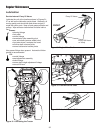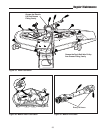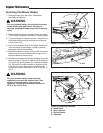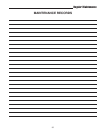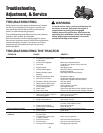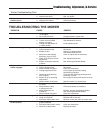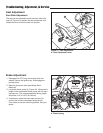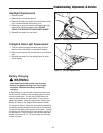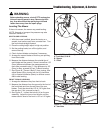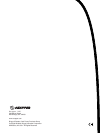
43
Specifications
ENGINE:
27 HP* Briggs & Stratton
Make Briggs & Stratton
Model DM 950 D - Model 582447
Horsepower 27 @ 3600 rpm
Displacement 58.1 cu in (952cc)
Electrical System 12 Volt, 40 amp. Alternator, Battery: 500 CCA
Oil Capacity 3.2 qt. (3L)
CHASSIS:
Fuel Tank Cap. 5.5 gal (20,8L)
Rear Wheels:
Turf Tires Tire Size: 26x12-12
Inflation Pressure: 12-15 psi (,83-1,03 bar)
HD Field Tires Tire Size: 26x12-12
Inflation Pressure: 10-12 psi (,69-,83 bar)
Front Wheels:
Turf Tires Tire Size: 18x8.5-8
Inflation Pressure.: 20-22 psi (1,38-1,52 bar)
HD Field Tires Tire Size: 18x8.5-10
Inflation Pressure.: 20-22 psi (1,38-1,52 bar)
TRANSAXLE:
Make Tuff Torq / Kanzaki
Type K92 Integrated Hydrostatic Pump & Transaxle
Hydraulic Fluid Type F Automatic Transmission Fluid
Capacity 2WD: 8 qt./7,6L, 4WD: 8.2 qt./7,8L,
4WD-540: 9.5 qt./9L
Speeds Forward: 0-9.0 mph (0-14,4 kph)
@ 3400 rpm Reverse: 0-5.5 mph (0-8,8 kph)
Continuous Torque 1200 ft-lbs (166 kg-m)
Output
Drawbar Rating 1111 lbs (504 kg)
Maximum Weight 1800 lbs (816 kg)
on Axle
FRONT AXLE (4WD):
Make Shibaura
Lubrication 80W-90 Gear Lube
Capacity 1.6 qt. (1,5L)
DIMENSIONS:
Overall Length 81”
Overall Width 47.25” (4WD)
Height 51”
Weight (apx..)
4WD Tractor, B&S Diesel 1131 lbs. (513 kg)
54” Mower Deck 230 lbs. (104 kg)
NOTE: Specifications are correct at time of printing and are subject to change without notice.
* The power ratings for an individual engine model are initially developed by starting with SAE (Society of Automotive
Engineers) code J1940 (Small Engine Power & Torque Rating Procedure) (Revision 2002–05). Given both the wide
array of products on which our engines are placed, and the variety of environmental issues applicable to operating
the equipment, it may be that the engine you have purchased will not develop the rated horsepower when used in a
piece of power equipment (actual “on–site” power). This difference is due to a variety of factors including, but not lim-
ited to, the following: differences in altitude, temperature, barometric pressure, humidity, fuel, engine lubrication, max-
imum governed engine speed, individual engine to engine variability, design of the particular piece of power equip-
ment, the manner in which the engine is operated, engine run–in to reduce friction and clean out of combustion
chambers, adjustments to the valves and carburetor, and other factors. The power ratings may also be adjusted
based on comparisons to other similar engines utilized in similar applications, and will therefore not necessarily match
the values derived using the foregoing codes.




